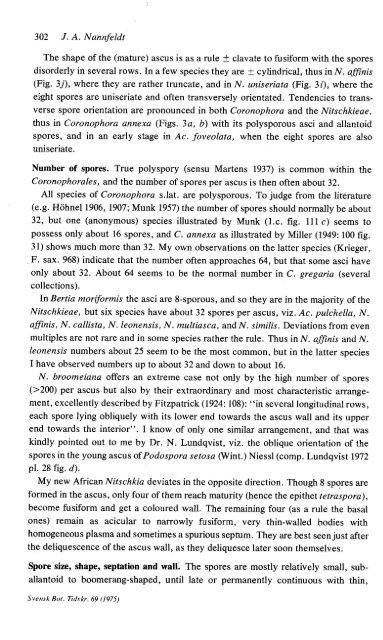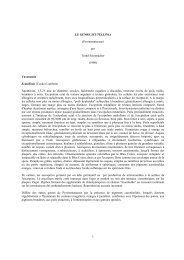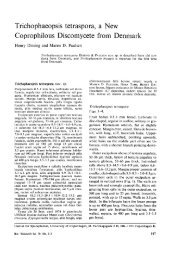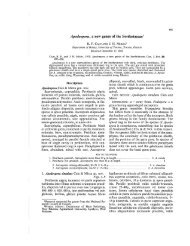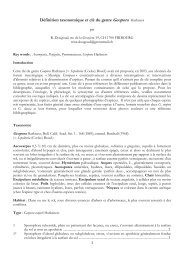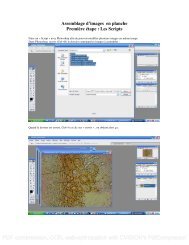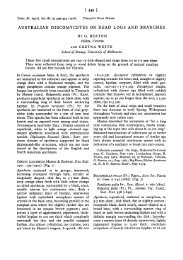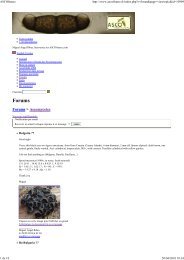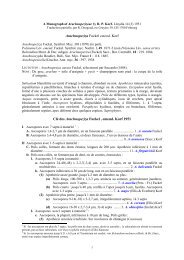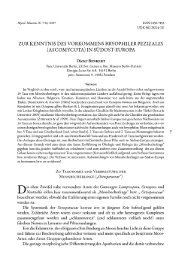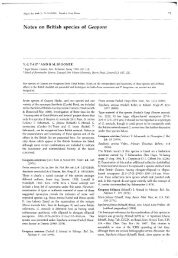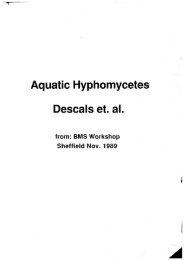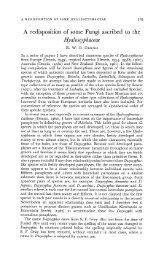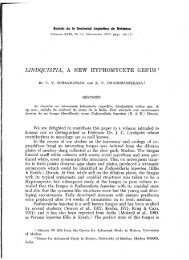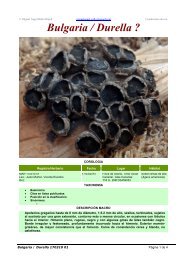Stray Studies in the Coronophorales (Pyrenomycetes) 4-8 - ASCOfrance
Stray Studies in the Coronophorales (Pyrenomycetes) 4-8 - ASCOfrance
Stray Studies in the Coronophorales (Pyrenomycetes) 4-8 - ASCOfrance
You also want an ePaper? Increase the reach of your titles
YUMPU automatically turns print PDFs into web optimized ePapers that Google loves.
302 J. A. NannfeldtThe shape of <strong>the</strong> (mature) ascus is as a rule ± clavate to fusiform with <strong>the</strong> sporesdisorderly <strong>in</strong> several rows. In a few species <strong>the</strong>y are ± cyl<strong>in</strong>drical, thus <strong>in</strong> N. aff<strong>in</strong>is(Fig. 3j), where <strong>the</strong>y are ra<strong>the</strong>r truncate, and <strong>in</strong> N. uniseriata (Fig. 3i), where <strong>the</strong>eight spores are uniseriate and often transversely orientated. Tendencies to transversespore orientation are pronounced <strong>in</strong> both Coronophora and <strong>the</strong> Nitschkieae,thus <strong>in</strong> Coronophora annexa (Figs. 3a, b) with its polysporous asci and allantoidspores, and <strong>in</strong> an early stage <strong>in</strong> Ac. foveolata, when <strong>the</strong> eight spores are alsouniseriate.Number of spores. True polyspory (sensu Martens 1937) is common with<strong>in</strong> <strong>the</strong><strong>Coronophorales</strong>, and <strong>the</strong> number of spores per ascus is <strong>the</strong>n often about 32.All species of Coronophora s.lat. are polysporous. To judge from <strong>the</strong> literature(e.g. Hohnel 1906, 1907; Munk 1957) <strong>the</strong> number of spores should normally be about32, but one (anonymous) species illustrated by Munk (I.e. fig. 111c) seems topossess only about 16 spores, and C. annexa as illustrated by Miller (1949:100 fig.31) shows much more than 32. My own observations on <strong>the</strong> latter species (Krieger,F. sax. 968) <strong>in</strong>dicate that <strong>the</strong> number often approaches 64, but that some asci haveonly about 32. About 64 seems to be <strong>the</strong> normal number <strong>in</strong> C. gregaria (severalcollections).In Bertia moriformis <strong>the</strong> asci are 8-sporous, and so <strong>the</strong>y are <strong>in</strong> <strong>the</strong> majority of <strong>the</strong>Nitschkieae, but six species have about 32 spores per ascus, viz. Ac. pulchella, N.aff<strong>in</strong>is, N. callista, N. leonensis, N. multiasca, and N. similis. Deviations from evenmultiples are not rare and <strong>in</strong> some species ra<strong>the</strong>r <strong>the</strong> rule. Thus <strong>in</strong> N. aff<strong>in</strong>is and N.leonensis numbers about 25 seem to be <strong>the</strong> most common, but <strong>in</strong> <strong>the</strong> latter speciesI have observed numbers up to about 32 and down to about 16.N. broomeiana offers an extreme case not only by <strong>the</strong> high number of spores(>200) per ascus but also by <strong>the</strong>ir extraord<strong>in</strong>ary and most characteristic arrangement,excellently described by Fitzpatrick (1924:108): "<strong>in</strong> several longitud<strong>in</strong>al rows,each spore ly<strong>in</strong>g obliquely with its lower end towards <strong>the</strong> ascus wall and its upperend towards <strong>the</strong> <strong>in</strong>terior". I know of only one similar arrangement, and that wask<strong>in</strong>dly po<strong>in</strong>ted out to me by Dr. N. Lundqvist, viz. <strong>the</strong> oblique orientation of <strong>the</strong>spores <strong>in</strong> <strong>the</strong> young ascus of Podospora setosa (W<strong>in</strong>t.) Niessl (comp. Lundqvist 1972pi. 28 fig. d).My new African Nitschkia deviates <strong>in</strong> <strong>the</strong> opposite direction. Though 8 spores areformed <strong>in</strong> <strong>the</strong> ascus, only four of <strong>the</strong>m reach maturity (hence <strong>the</strong> epi<strong>the</strong>t tetraspora),become fusiform and get a coloured wall. The rema<strong>in</strong><strong>in</strong>g four (as a rule <strong>the</strong> basalones) rema<strong>in</strong> as acicular to narrowly fusiform, very th<strong>in</strong>-walled bodies withhomogeneous plasma and sometimes a spurious septum. They are best seen just after<strong>the</strong> deliquescence of <strong>the</strong> ascus wall, as <strong>the</strong>y deliquesce later soon <strong>the</strong>mselves.Spore size, shape, septation and wall. The spores are mostly relatively small, suballantoidto boomerang-shaped, until late or permanently cont<strong>in</strong>uous with th<strong>in</strong>,Svensk Bot. Tidskr. 69


